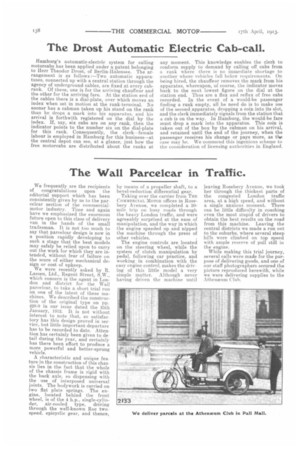The Wall Parcelcar in Traffic.
Page 14

If you've noticed an error in this article please click here to report it so we can fix it.
We frequently are the recipients of congratulations upon the editorial support which has been consistently given by us to the parcelear section of the commercialmotor industry. Time and again have we emphasized the enormous future open to this class of delivery van in the hands of the small tradesman. It is not too much to say that parcelcar design is now in a position rapidly developing to such a stage that the best models may safely be relied upon to carry out the work for which they are intended, without fear of failure on the score of either mechanical design or cost of upkeep.
We were recently asked by R. Lassen, Ltd., Regent Street, S.W., which concern is the agent in London and district for the Wall parcelcar, to take a short trial run on one of the latest of these machines. We described the construction of the original type on pp. 428-9 in our issue dated the 25th January, 1912. It is not without interest to note that, so satisfactory has this design proved in service, but little important departure has to be recorded to date. Attention has certainly been given to detail during the year, and certainly has there been effort to produce a more powerful and better-sprung vehicle.
A characteristic and unique feature in the construction of this chassis lies in the fact that the whole of the chassis frame is rigid with the back axle, so dispensing with the use of interposed universal joints. The bodywork is carried on two flat plate springs. The engine, located behind the front wheel, is of the 4 h.p., single-cylinder, air-cooled type, driving through the wen-known Roc twospeed, epicyclic gear, and thence,
by means of a propeller shaft, to a bevel-reduction differential gear.
Taking over the carrier from THE COMMERCIAL MOTOR offices in Rosebery Avenue, we completed a 30mile trip on busy roads through the heavy London traffic, and were agreeably surprised at the ease of manipulation, and the way in which the engine speeded up and nipped the machine through the press of other vehicles. The engine controls are located on the steering wheel, while the system of clutch manipulation by pedal, following car practice, and working. in combination with the easy engine control, makes the driving of this little model a very simple matter. Although never having driven the machine until
leaving Rosebery Avenue, we took her through the thickest parts of the congested London traffic area, at a high speed, and without a single anxious moment. There can be little difficulty in coaching even the most stupid of drivers to obtain the best results on the road from this machine. Leaving the central districts we made a run out to the suburbs, where several steep hills were climbed on top speed with ample reserve of pull still in the engine. While making this trial journey, several calls were made for the purpose of delivering goods, and one of our staff photographers secured the picture reproduced herewith, while we were delivering supplies to the Athenaeum Club.






















